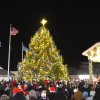One would think that gardeners would cheerfully say good riddance to winter, but we know one part of that season will be missed: feeding wild birds.
One of the most playful winter garden visitors is the chickadee. The name chickadee is an onomatopoeia, a word formed in imitation of the birds' calls that sound like “chick-a-dee-dee-dee.” You may notice when listening to a chickadee’s call that sometimes there is only one “dee” at the end, while at other times the sound is repeated. There is actually a code to the number of dees. One dee indicates that there is no threat, but five dees at the end of the call is an alarm that there is a predator nearby.
Chickadees are popular because of how friendly they are toward humans. Some folks have even had chickadees eat out of their hand. The top or cap of the chickadee’s head and the chest bib are black, while their cheeks are white, their backs are gray, the wings a blend of gray and white, and the body beneath the wings is a light tan.
These tiny birds, weighing only a half-ounce, frequent winter feeders to eat sunflower seeds and suet, even if over 75 percent of their winter diet comes from natural sources. The chickadees’ survival rate almost doubles if they have access to home bird feeders when temperatures fall below 10 degrees.
Place your bird feeders and birdbath near dense, thicket-like parts of the yard so the birds have a safe, easy retreat. Plant a mix of different-sized trees and shrubs, including evergreens, to give the chickadees foraging areas and thick shelter for protection.
Chickadees mate for life and will carve out their own nest holes in dead or decaying trees. They also will use old nest holes left by other birds such as woodpeckers, and will find a homemade nesting box an acceptable choice, too. Chickadees may even use birdhouses in the winter for shelter, not for nesting.
They lay 6-8 speckled red over white eggs that hatch in 12 days. The young leave the nest just 21 days later.
One way to attract chickadees to your yard is with a birdbath, especially if it features moving water. You can add a small solar-powered fountain to your birdbath to keep the water moving and fresh.
Chickadees will eat dried mealworms, berries, peanut butter, suet and black-oil sunflower seeds.
Trees to plant to bring chickadees to your yard include eastern red cedar, white pine, sugar maple, honey locust (Gleditsia triacanthos), fruiting mulberry and serviceberry.
Flowers that will bring chickadees to your garden include New England aster (Symphyotrichum novae-angliae) tulips, sunflowers, bee balm (Monarda), columbines, black-eyed Susans and goldenrod.
Black-eyed Susans interplanted with New England asters create a low-maintenance flowerbed. Let some of your roses grow fruit (called rose hips) for a high-energy food source. Even flowering weeds such as dandelions provide seeds for chickadees. Leave the seed heads on the plants over the winter so they can provide food for chickadees along with beneficial pollinators such as butterflies and moths.
Just because it is spring doesn't mean you have to say goodbye to your winter feeder friends. Plant black-eyed Susans and New England asters, and keep your little buddies nearby all year long. You may have friends for life.























































